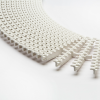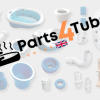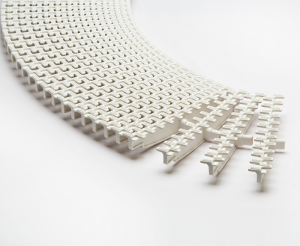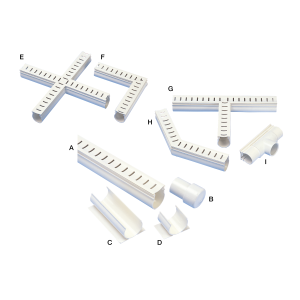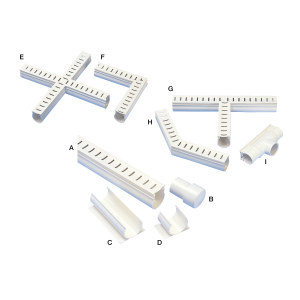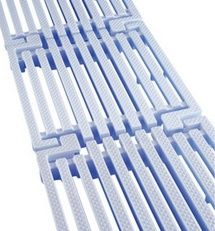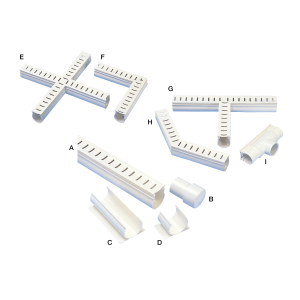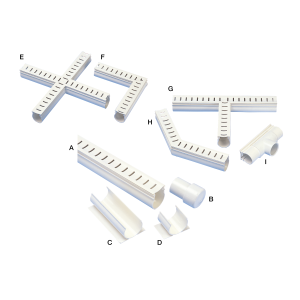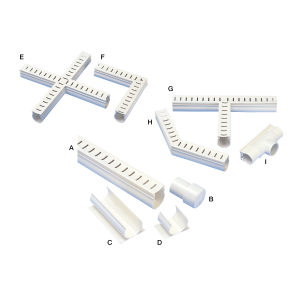HD106200-S1N | Overflow grating 200mm wide x 20mm, single spine
£50.84 Inc VAT
HD106200-S1N | Overflow Grating 200mm Wide x 20mm, Single Spine
The Essential Surface Component for Deck-Level and Infinity Pools
When you’ve invested in creating a stunning deck-level or infinity pool with its sophisticated overflow drainage system hidden beneath, there’s one crucial component that brings everything together: the overflow grating. The HD106200-S1N Overflow Grating—measuring 200mm wide by 20mm deep with single spine construction—is the visible finishing element that transforms your overflow channel from a functional necessity into an elegant design feature. This is where engineering meets aesthetics, providing safe, attractive coverage for your overflow system while enabling the continuous water collection that makes deck-level pools so visually stunning.
What is Overflow Grating?
As a retailer of hot tub spare parts, I work with customers who range from residential pool owners to commercial facility managers, and one thing I’ve learned is that overflow grating is far more than just a decorative cover. It’s a carefully engineered component that must perform multiple critical functions simultaneously.
Overflow grating is the perforated or slotted surface cover that sits atop your overflow channel at the pool’s perimeter. In deck-level pools—where the water surface sits level with the surrounding deck—water constantly overflows into the perimeter channel, and the grating covers this channel while allowing water to pass through. The grating provides a safe walking surface, prevents debris from entering the drainage system, and creates the clean, sophisticated aesthetic that defines modern pool design.
Understanding Deck-Level and Infinity Pool Systems
To appreciate why proper overflow grating matters, it helps to understand how deck-level pools work:
The Deck-Level Pool Concept
In traditional pools, water sits 150mm or more below the deck level, with skimmers collecting surface water. Deck-level pools take a different approach: the water surface sits flush with the surrounding deck, creating a stunning mirror-like effect. Water continuously overflows around the entire perimeter into a covered channel, flowing to a balance tank where it’s pumped back through the filtration system.
This perimeter overflow system offers significant advantages: the entire pool edge acts as one continuous skimmer, providing superior surface debris removal; the flat water surface creates perfect reflections; and the visual effect is dramatically more elegant than traditional pools with visible water lines and skimmer boxes.
The Role of Overflow Grating
The overflow grating is the critical interface between water and deck. It must:
- Allow free water passage so overflow occurs smoothly and silently
- Provide safe footing for people walking around the pool edge
- Prevent debris entry keeping leaves, toys, and objects out of the drainage channel
- Support loads from foot traffic, furniture, and equipment
- Maintain aesthetics presenting a clean, attractive pool perimeter
- Enable maintenance access allowing channel cleaning when needed
Key Features and Benefits
Single Spine Construction
The “single spine” design refers to the structural support running along the center of each grating section. This central reinforcement provides strength and rigidity while keeping weight and material use economical. Single spine grating offers a cost-effective solution that’s easy to install and perfectly suited for residential pools and many commercial applications.
Compared to double spine designs (which have two parallel supports for extra strength), single spine grating is lighter, more flexible for curved applications, and simpler to work with during installation. For most standard pool applications, single spine construction provides entirely adequate strength and durability.
200mm Width Specification
The 200mm width is one of the most common standard sizes for overflow grating, offering an excellent balance between coverage and drainage performance. This width is suitable for:
- Standard residential deck-level pools
- Medium-traffic commercial installations
- Spa and hot tub perimeter overflows
- Retrofit projects replacing existing grating
The 200mm dimension typically matches standard overflow channel widths, ensuring proper fit and optimal performance when installed correctly.
20mm Depth Profile
At 20mm deep, this grating provides a low-profile finish that integrates seamlessly with most deck installations. The shallow depth ensures minimal protrusion above the deck surface while still providing adequate structural strength and water passage capacity. This dimension is designed to match standard coping heights and deck levels commonly used in pool construction.
Durable HDPE Construction
Modern overflow grating is typically manufactured from High Density Polyethylene (HDPE) or UV-stabilized polypropylene—materials specifically chosen for pool environments. These advanced plastics offer:
- UV resistance: Won’t fade, crack, or degrade from constant sun exposure
- Chemical resistance: Unaffected by chlorine, bromine, salt, and other pool chemicals
- Corrosion immunity: Unlike metal grating, will never rust or corrode
- Temperature stability: Performs reliably through seasonal temperature variations
- Low maintenance: Simple to clean and requires no special treatments
- Long service life: Decades of reliable performance when properly installed
Anti-Slip Surface
Safety is paramount around pool edges. The HD106200-S1N features an anti-slip surface texture that provides secure footing even when wet. This textured finish also offers a subtle massage effect for bare feet—a small detail that contributes to overall pool enjoyment and comfort.
Modular Design
Overflow grating sections connect together to form continuous runs around your pool perimeter. Individual sections clip or lock together, creating:
- Flexibility for curves: Can follow pool contours and gentle curves
- Easy installation: Sections join quickly without special tools
- Simplified maintenance: Individual sections can be removed for channel cleaning
- Repair convenience: Damaged sections can be replaced without disturbing adjacent grating
Applications and Pool Types
Residential Deck-Level Pools
For homeowners who’ve chosen the elegant deck-level pool design, overflow grating is the finishing touch that brings the vision to life. The continuous perimeter of grating creates clean lines and a sophisticated appearance that elevates the entire outdoor space.
Commercial and Public Pools
In hotels, resorts, aquatic centers, and public pools, deck-level designs with overflow grating provide both aesthetic appeal and superior water quality through constant surface skimming. The enhanced debris removal helps maintain cleanliness in high-use environments.
Infinity and Negative Edge Pools
While true infinity pools typically have one exposed overflow edge without grating, many incorporate deck-level overflow on the remaining sides, requiring grating for those perimeter sections. The combination creates dramatic visual effects while maintaining practical functionality.
Spa and Hot Tub Installations
Elevated spas with overflow edges, integrated spa-pool combinations, and standalone hot tubs frequently use overflow grating to manage water spillover elegantly. The 200mm width is particularly well-suited to spa applications where space is more limited than full-size pools.
Indoor Pool Facilities
Indoor pools particularly benefit from deck-level overflow systems with proper grating, as the reduced splashing and continuous surface skimming help control humidity while maintaining pristine water quality.
Installation Considerations
Channel Compatibility
Ensure your overflow grating matches your channel system specifications:
- Width alignment: 200mm grating requires 200mm channel width
- Depth clearance: 20mm grating depth must suit your channel design
- Connection type: Verify grating connection method matches your system
Proper Positioning
Overflow grating must be installed with precision:
- Level installation: Grating should sit perfectly level for even water overflow
- Consistent height: Maintain uniform height around entire pool perimeter
- Secure fitting: Ensure grating sections are properly locked or seated in channels
- Gap management: Connections between sections should be tight to prevent debris entry
Slope and Drainage
The deck surrounding your pool should slope very slightly toward the overflow grating (reverse slope) to prevent water from the deck mixing with pool water while still directing deck drainage appropriately.
Water Level Management
In deck-level pools, water level must be precisely maintained to ensure proper overflow function. Automatic level control systems monitor and adjust water height, keeping overflow consistent even as bathers displace water or evaporation occurs.
Maintenance and Care
Regular Cleaning
Overflow grating requires periodic maintenance:
- Remove surface debris: Brush off leaves, dirt, and other materials regularly
- Lift for channel cleaning: Periodically remove grating sections to clean the channel beneath
- Pressure wash: Use low-pressure water to clean grating surfaces
- Check connections: Ensure grating sections remain properly joined and seated
Inspection Schedule
Regularly inspect your overflow grating for:
- Damage or cracks: Replace any broken sections promptly
- Secure positioning: Verify grating hasn’t shifted or loosened
- Flow performance: Ensure water overflows smoothly without backing up
- Anti-slip condition: Check that textured surface remains effective
Replacement Indicators
Know when to replace grating sections:
- Visible cracks or structural damage
- Fading or UV degradation (though quality HDPE resists this)
- Warping that prevents proper fit
- Loss of anti-slip properties
- Outdated appearance when renovating pool area
Technical Specifications
| Specification | Detail |
|---|---|
| Product Code | HD106200-S1N |
| Product Type | Overflow Swimming Pool Grating |
| Width | 200mm |
| Depth/Height | 20mm |
| Construction Type | Single Spine |
| Material | High Density Polyethylene (HDPE) / UV-stabilized polypropylene |
| Color | Typically white or light grey (specify when ordering) |
| Surface Finish | Anti-slip textured surface |
| UV Protection | Yes – UV stabilized for outdoor use |
| Chemical Resistance | Resistant to chlorine, bromine, salt, and common pool chemicals |
| Load Class | Suitable for pedestrian traffic |
| Gap Size | Designed to meet EN-13451-1 standards (typically 8-11mm) |
| Temperature Range | Suitable for seasonal outdoor use and indoor installations |
| Installation Method | Clip-together modular sections |
| Application | Deck-level pools, infinity pools, spas, overflow channels |
| Maintenance | Low maintenance – periodic cleaning and inspection |
| Expected Lifespan | 10-20+ years with proper care |
| Compliance | Designed to meet relevant safety and pool standards |
Design Impact and Aesthetic Value
While overflow grating is fundamentally a functional component, its aesthetic impact shouldn’t be underestimated. The clean lines of properly installed grating contribute significantly to the sophisticated appearance that makes deck-level pools so desirable.
The color choice matters: white or light grey grating provides a crisp, clean look that works with most pool finishes and surrounding materials. The subtle anti-slip texture adds visual interest without being obtrusive. When water overflows smoothly and silently across the grating, the overall effect is one of refined elegance—the pool appears to float on the deck like a perfect mirror.
Why Quality Grating Matters
In my experience supplying pool components, I’ve seen the problems that occur when substandard grating is used:
- Inadequate strength leading to flexing, bowing, or breakage under load
- Poor UV resistance causing rapid fading, embrittlement, and failure
- Improper sizing creating gaps, misalignments, or flow restrictions
- Inferior materials that don’t withstand chemical exposure or temperature extremes
The HD106200-S1N represents quality manufacturing specifically for pool applications. While it might cost more than generic alternatives, the performance, durability, and long-term reliability justify the investment. Remember that replacing failed grating requires not just new materials but also labor for removal and installation—costs that far exceed the initial savings from cheaper products.
Professional Installation Recommendations
While overflow grating installation might seem straightforward, professional installation ensures:
- Proper channel preparation before grating placement
- Correct leveling for optimal overflow performance
- Secure fitting preventing movement or displacement
- Attention to details like connection tightness and alignment
- System testing to verify proper water flow and drainage
For new installations, coordinate grating selection and purchase with your pool builder. For replacement projects, verify exact measurements and specifications before ordering to ensure compatibility with your existing system.
Note: Overflow grating is a critical safety and functional component. Always ensure your grating meets relevant safety standards and local building codes. Professional installation is recommended to ensure optimal performance and longevity.
Related products
Overflow Grating & Drainage Channel
Overflow Grating & Drainage Channel
Overflow Grating & Drainage Channel
Overflow Grating & Drainage Channel
Overflow Grating & Drainage Channel
Overflow Grating & Drainage Channel
Overflow Grating & Drainage Channel
Overflow Grating & Drainage Channel

